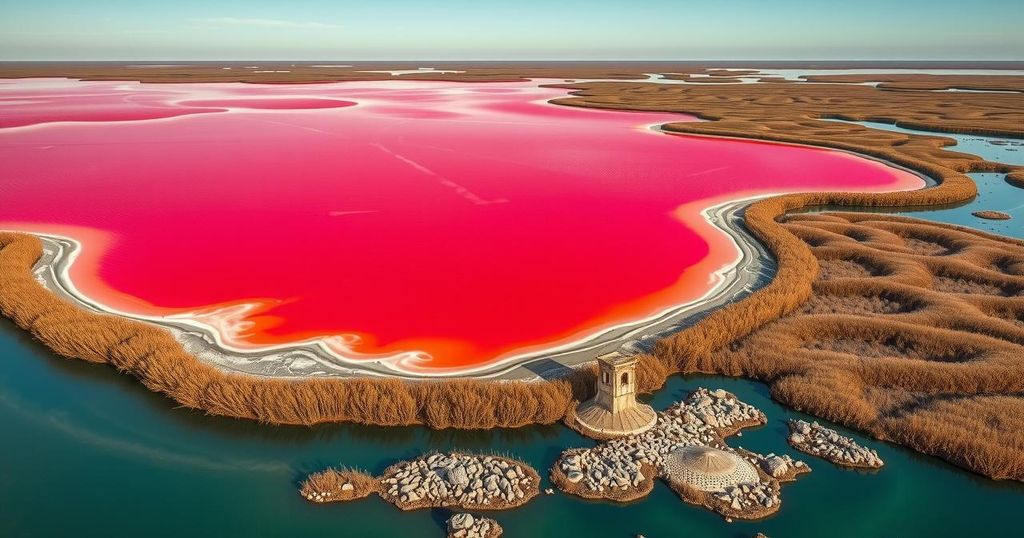Lake Natron: Tanzania’s Blood-Red Lake That Turns Animals to Stone

Lake Natron in Tanzania is a shallow, caustic lake known for its striking crimson colors, caused by microorganisms. The lake transforms deceased animals into calcified sculptures due to its high sodium carbonate concentration. Ironically, it serves as a breeding ground for lesser flamingos, who have adapted to thrive in this extreme environment. Conservation efforts are crucial to protect this unique ecological balance.
Nestled in the heart of Tanzania, Lake Natron presents a captivating paradox. This red-hued lake, renowned for its striking beauty, also boasts some of the deadliest conditions found in nature. A rich ecosystem amid a hostile environment, Lake Natron has a unique ability to transform deceased animals into eerie, calcified statues, making it one of Africa’s most extraordinary natural phenomena.
Lake Natron stretches across northern Tanzania and is a shallow basin that gleams with an unusual crimson hue, a vivid sight under the African sun. This remarkable coloration is produced by specialized microorganisms that flourish in the lake’s alkaline waters. Salt-tolerant haloarchaea and cyanobacteria contribute vibrant red pigments as a survival tactic in this extreme setting. The lake’s waters can be unbearable, with pH levels reaching around 10.5, quite similar to household ammonia, causing harm to most animals that come too close.
Volcanic activity in the East African Rift System shapes the lake’s chemistry, with minerals like sodium carbonate and calcium carbonate filtering in from surrounding hills. During dry seasons, Lake Natron shrinks significantly. Water temperatures can reach a staggering 140°F (60°C), creating a hostile environment comparable to a boiling pot. The lake is shallow too, usually just 1.6 feet deep, which allows rapid evaporation and considerable seasonal changes.
One of the most macabre aspects of Lake Natron is its capability to turn deceased wildlife into stone-like sculptures. When animals die near its shores, they undergo a preservation process driven by the lake’s high sodium carbonate concentration. This chemical reaction essentially mummifies the remains, as mineral deposits replace the organic tissues. In 2013, photographer Nick Brandt highlighted this chilling phenomenon, capturing perfectly preserved birds and bats in his series “Across the Ravaged Land.” His haunting images show these creatures as ghostly statues, frozen in time yet seeming lifelike.
The petrification process is swift. Carcasses quickly absorb the mineral-enriched water, and as evaporation occurs, calcium carbonate forms in their tissues. These remains end up resembling alabaster statues; beautifully preserved yet lifeless. It serves as a natural form of preservation similar to the methods that researchers employ to study ecosystems, underscoring Lake Natron’s unique chemical characteristics that do this without human intervention.
Ironically, despite its lethal properties, Lake Natron is crucial for some remarkable species. The lake is the primary breeding habitat for lesser flamingos (Phoeniconaias minor), which manage to thrive in this inhospitable environment. Thanks to adaptations like tough, scaly legs and specialized beaks, these elegant birds safely navigate the caustic waters. It is estimated that about 1.5 to 2.5 million lesser flamingos, representing roughly 75% of their global population, depend on this lake for breeding, creating nests on small islands formed during the dry season to keep predators at bay.
Interestingly, the microorganisms that give the lake its distinctive color also provide essential nutrients for the flamingos, contributing to their vibrant pink plumage. This dynamic food chain illustrates how life can adapt and thrive in even the harshest environments.
For those adventurous enough to explore Lake Natron, proper planning is essential. Guided tours with local experts can help ensure visitor safety while allowing them to appreciate the stunning scenery and watch the flamingos from a distance. The landscape around the lake includes salt marshes and freshwater wetlands that attract various wildlife like pelicans and wildebeest, offering a buffer zone perfect for safe observation.
Efforts to maintain Lake Natron’s ecological balance are underway, with the Tanzania Wildlife Management Authority enforcing strict tourism regulations. These measures aim to protect both the flamingo breeding patterns and the lake’s delicate chemical equilibrium, ensuring that future generations can enjoy the unique splendour of this extraordinary natural site.
Ultimately, Lake Natron serves as a powerful reminder of nature’s extremes. The lake’s blood-red waters and the stone-like remains of animals reflect both the resilience of life and the planet’s diverse ecosystems, showcasing a remarkable balance of beauty and danger.
Lake Natron stands as a striking testament to nature’s extremes and its ability to foster life in the most inhospitable conditions. From the haunting transformation of animals into calcified statues to the thriving lesser flamingos, this unique ecosystem challenges our understanding of survival. Conservation efforts remain critical to preserve its delicate balance, ensuring both its eerie beauty and ecosystems are protected for the future.
Original Source: thinkstewartville.com






